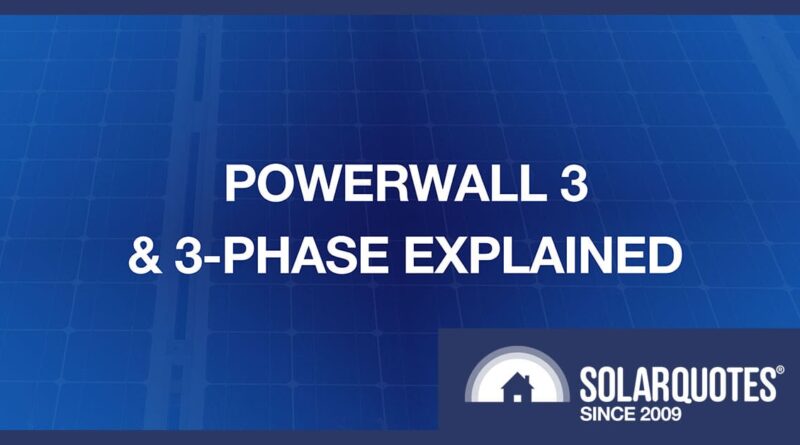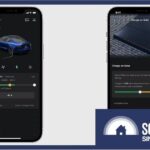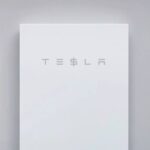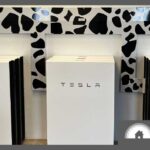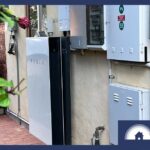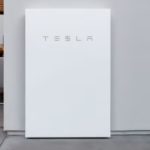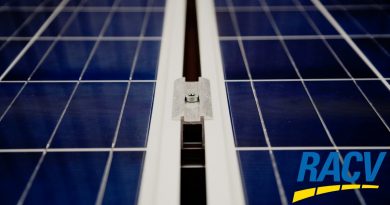Can You Install The Powerwall 3 On A Three-Phase Home?
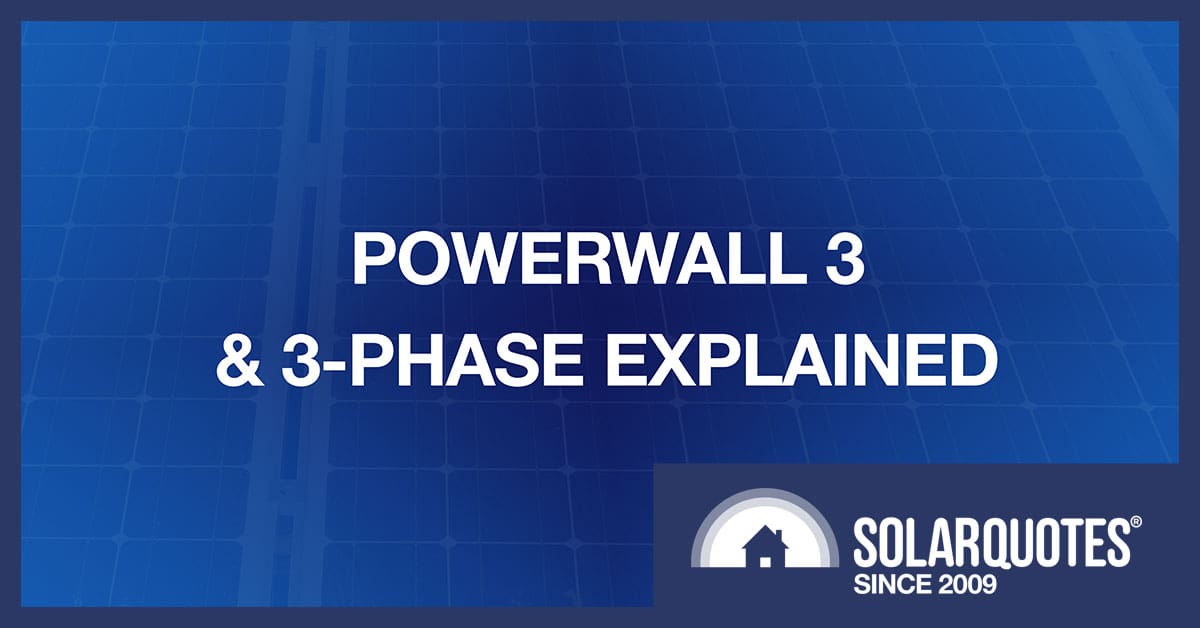
Australians sure are excited about the Tesla Powerwall 3, and we are getting truckloads of queries about it.
The most common question by far is:
Can I put a Powerwall 3 on my 3-phase home?
The short answer is:
Yes. Although the Powerwall 3 is a single-phase battery, it will work perfectly on a three-phase home while the grid is connected, offsetting your electricity bill on all three phases, just as it would on a single-phase home.
But when the grid goes down, the battery function will be compromised.
How the Powerwall 3 functions with your 3 phases will depend on how it’s wired into your home. In this post, I’ll go through all the ways this can be done that I can think of, so you can assess which configuration works best for you, or if you’d be better off getting a battery system designed for 3-phase homes from the likes of Fronius, Sungrow, iStore, SigEnergy or others.
In Australia, Powerwall 3s are installed with a ‘Backup Gateway 2’. The Backup Gateway 2 handles backup switching duties and the measurement of power flows in and out of your house, which the Powerwall control software uses for monitoring and control.
In all these scenarios, I am assuming you have a 3-phase utility meter, not 3 single-phase meters.
I also assume your local DNSP allows these configurations.
Your PW3 can be configured by Tesla to have 5kW, 10kW or 11kW output, depending on your local regulations. I’m assuming a 10kW version here.
Config #1: Powerwall 3 + Solar on a 3P home (no existing solar)
If you want to add a single Powerwall 3 and up to 20 kW of solar panels to a 3-phase home, the best way to do this is to add the powerwall and solar to one of the three phases like this.
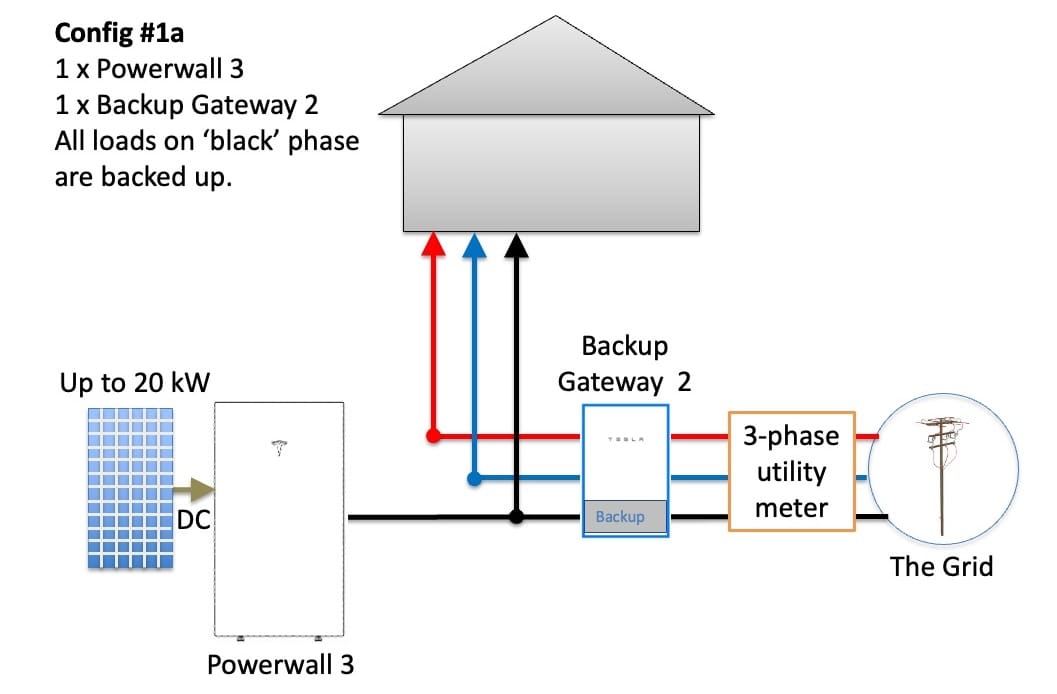
1 Powerwall 3, 1 Gateway 2, all the ‘black’ phase is backed up.
The Powerwall 3 accepts up to 20 kW of solar panels. Depending on the software configuration, it can charge the battery using solar, the grid, or both.
All 3 phases are offset for billing
Although the Powerwall can only discharge on the black1 phase, the Gateway measures the power flows on all 3 phases, and discharges enough on the black phase to cover the power coming in from the grid across all phases. The 3-phase utility meter subtracts the power flow going out of the black phase from any power coming in on the blue and red phases, and only bills you for the difference. If the battery has enough energy, that will be zero dollars2. There is a detailed explanation of this with pictures here.
Only the black phase is backed-up
If the grid goes down, the house will lose the blue and red phases. Only the black phase will be backed up, and the solar going into the PW3 will still operate just fine. So, all the essential circuits should be placed on the black phase.
You can have non-backed-up circuits on the black phase
If there are loads on your black phase that you don’t want to back up (for example one phase of a 3-phase appliance) you can have a non-backed up circuit on the Powerwall phase.
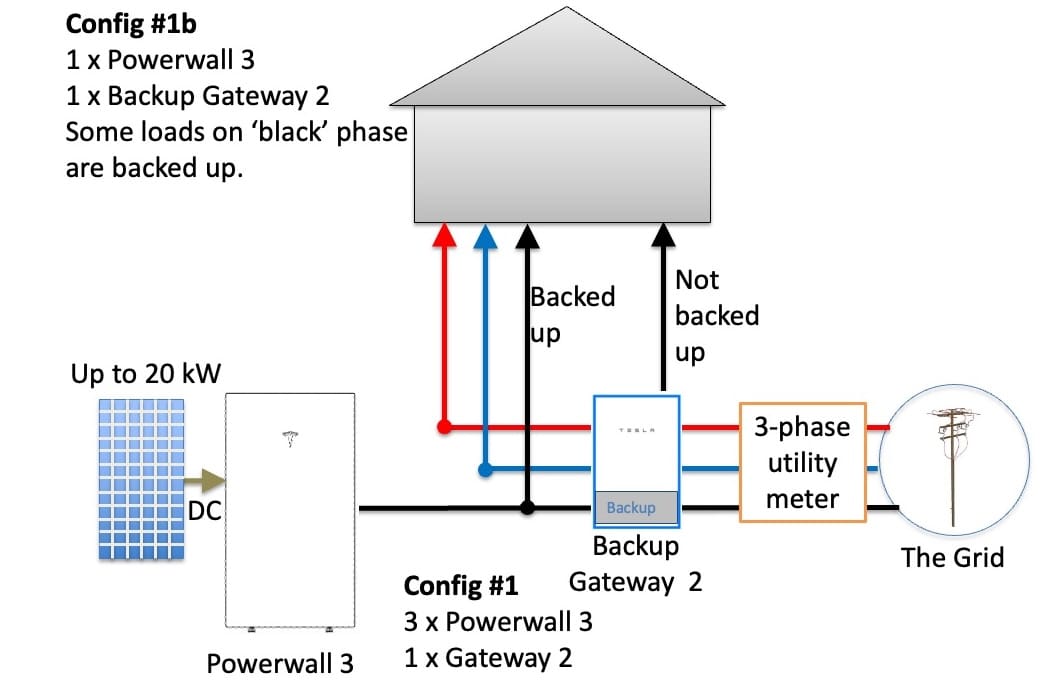
1 Powerwall 3, 1 Gateway, Some loads on black phase are backed up.
Config #2: Powerwall 3 on a 3P home with existing single-phase solar
If you have existing solar and your inverter is 5kW or less, and you want to retrofit just a battery, you can use a Powerwall 3 as shown.
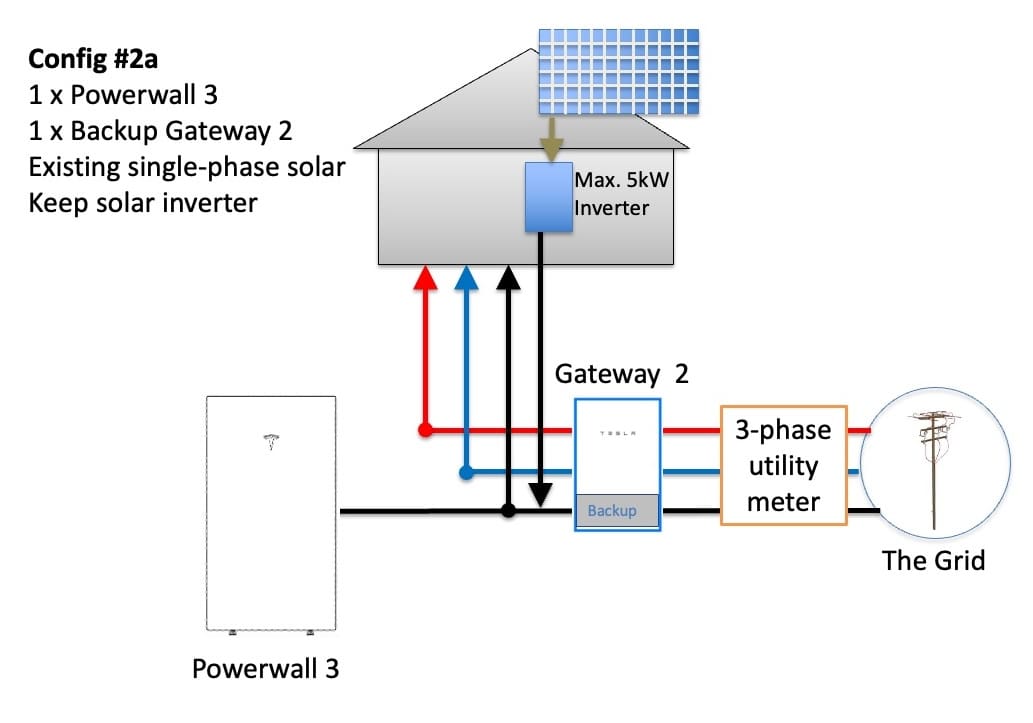
1 Powerwall 3, 1 Gateway, existing single-phase solar keeping solar inverter
The existing solar goes on the same phase as the PW3, and the existing solar inverter can charge the battery with AC power.
If the grid goes down, the black phase is backed up, and your solar inverter will stay online.
Ditching your solar inverter
An alternative variant is to disconnect your existing solar array from your old inverter and plug it into the PW3:
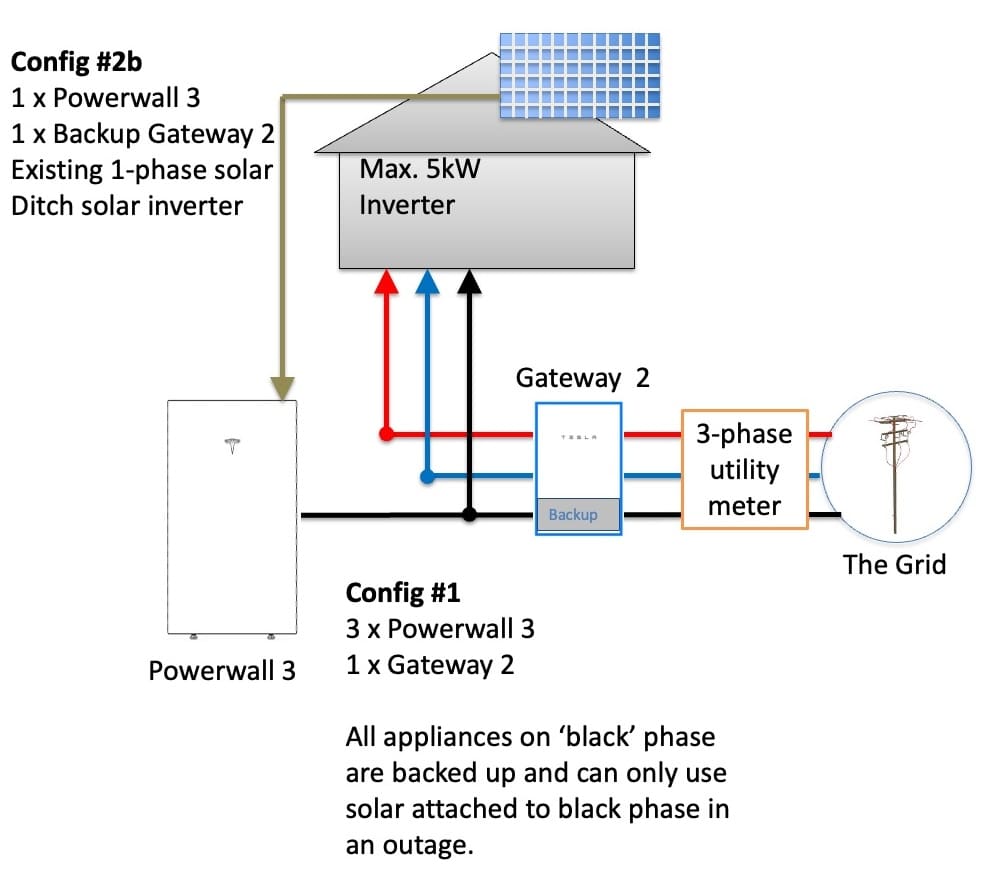
1 Powerwall 3, 1 Gateway, existing single-phase solar ditching solar inverter
This has many advantages:
- One less inverter on the wall.
- You get a 10-year warranty on the PW3’s internal solar inverter.
- Battery charging is a little more efficient
- Better monitoring of the solar all through the Tesla App
- Better control of the solar
Whether this is possible will depend on the age of your solar panels and your local network rules. Your installer can advise.
Local rules may force you to ditch your old inverter. See the end of this post for more details.
Powerwall 2 is a cheaper option
If you have existing single-phase solar and want to add a battery on 3 phase, the Powerwall 2 offers the same storage and 5 kW of output for at least $1,500 less.
Config #3: Powerwall 3 + solar on a 3P home with existing single-phase solar
The smart way to configure this is to put the existing solar on one of the 2 non-Powerwall phases and the new solar into the Powerwall.
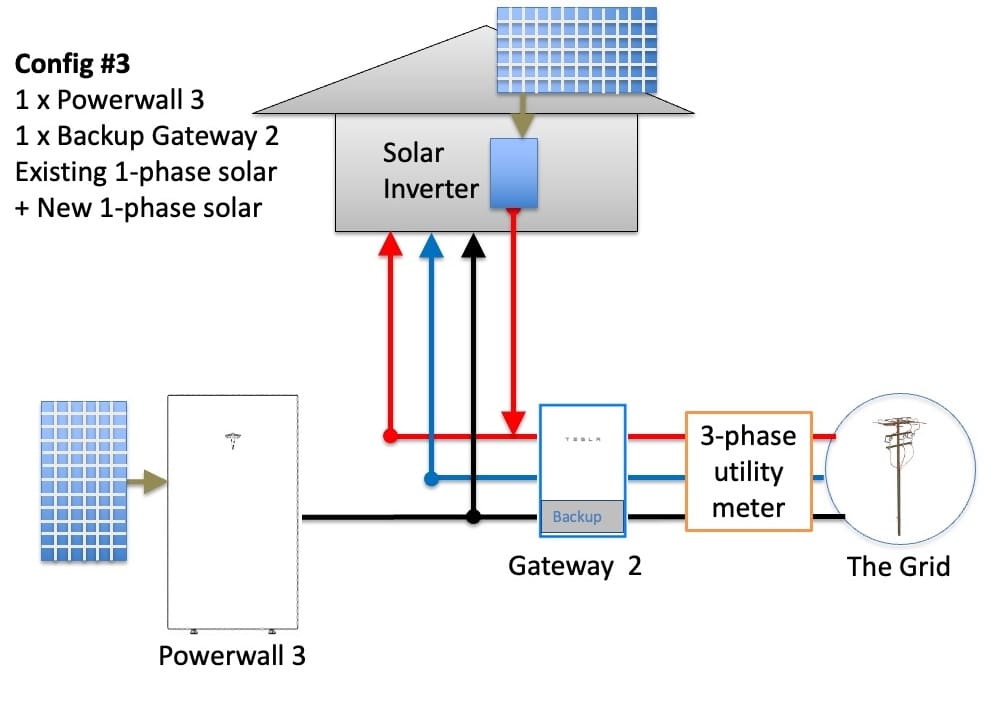
Existing 1-phase solar
+ new 1-phase solar
You won’t have to touch the old solar (or its warranty), and that old array will do everything except charge the battery in an outage.
Config #4: Powerwall 3 on a 3P home with existing 3-phase solar
If you’ve got a roof full of solar on an existing 3-phase inverter, you have some options.
Option 1. Use Powerwall 3 just as a battery
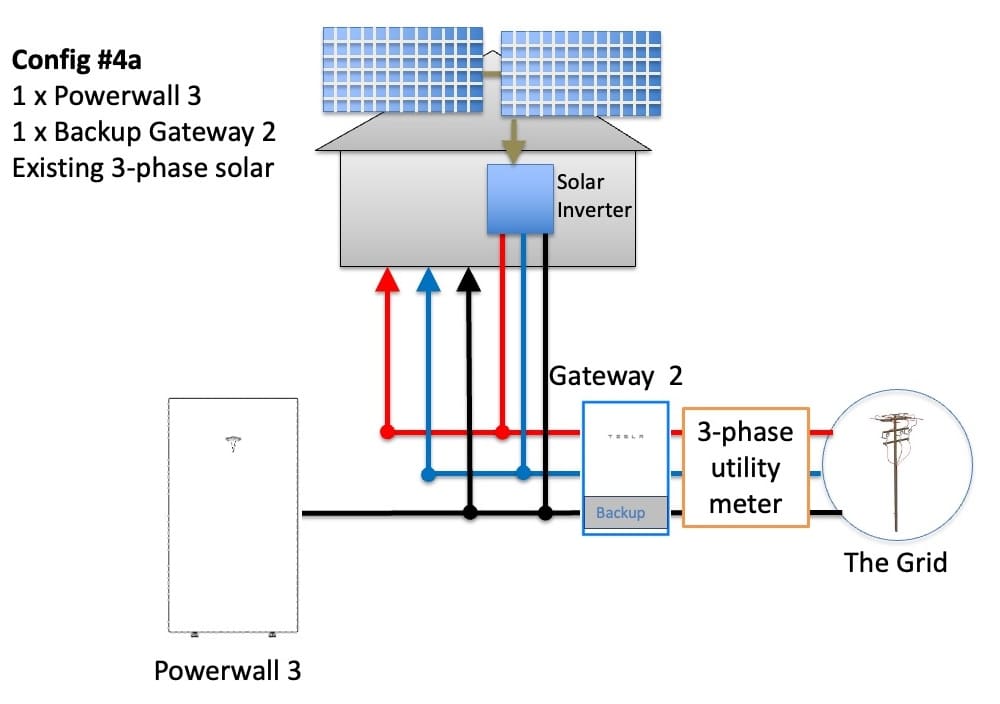
Existing 3-phase solar
In this configuration, the black phase will be backed up, but you’ll have no solar during an outage, because your solar inverter needs a 3 phase supply to operate.
Option 2. Put some or all of your solar into the single-phase Powerwall 3.
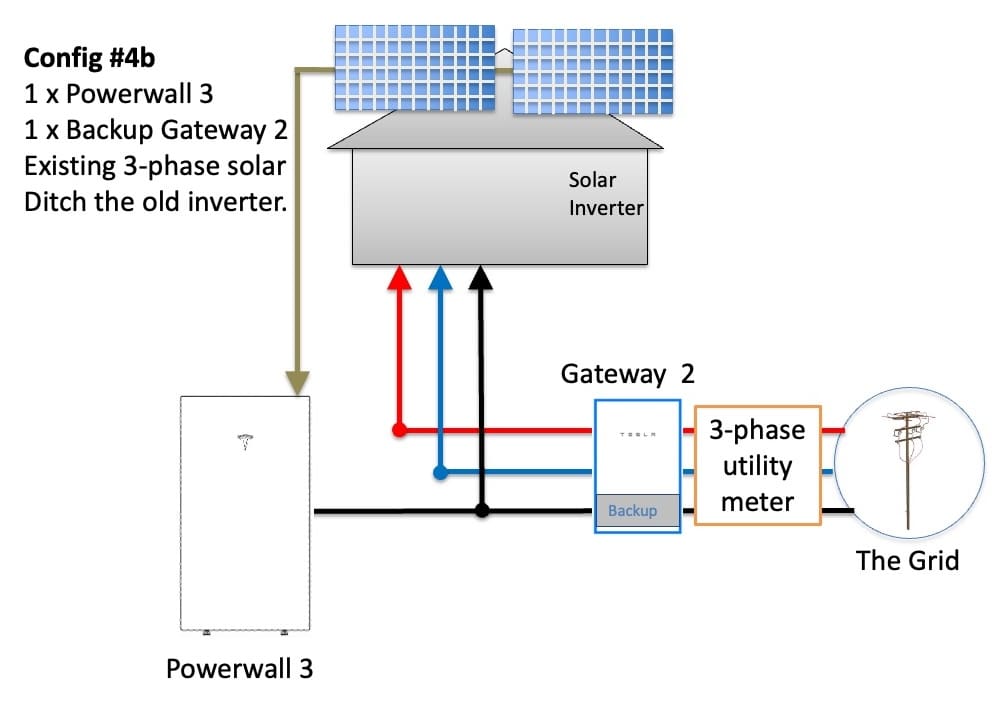
Existing 3-phase solar into the PW3
If your solar array is 20kW or less, it is plugged into the PW3 and will operate during an outage. When connected to the grid, all your solar will work.
Whether this is possible depends on age of your panels and your array design. A good installer can advise. Tesla warranty is not affected by connecting legacy panels.
One issue with putting all of the old solar through the PW3 is that you may encounter voltage rise issues when exporting lots of solar out of one phase instead of across 3, your solar will be clipped at 10 kW when the battery is full, and your DNSP might prohibit it (Hello WA!).
Config #5: Powerwall 3 on a 3P home with existing microinverters.
Only the microinverters on the same phase as the PW3 will work in an outage. You can only have 5kW of micros on the black phase. With the grid connected all the micros across all 3 phases will work fine.
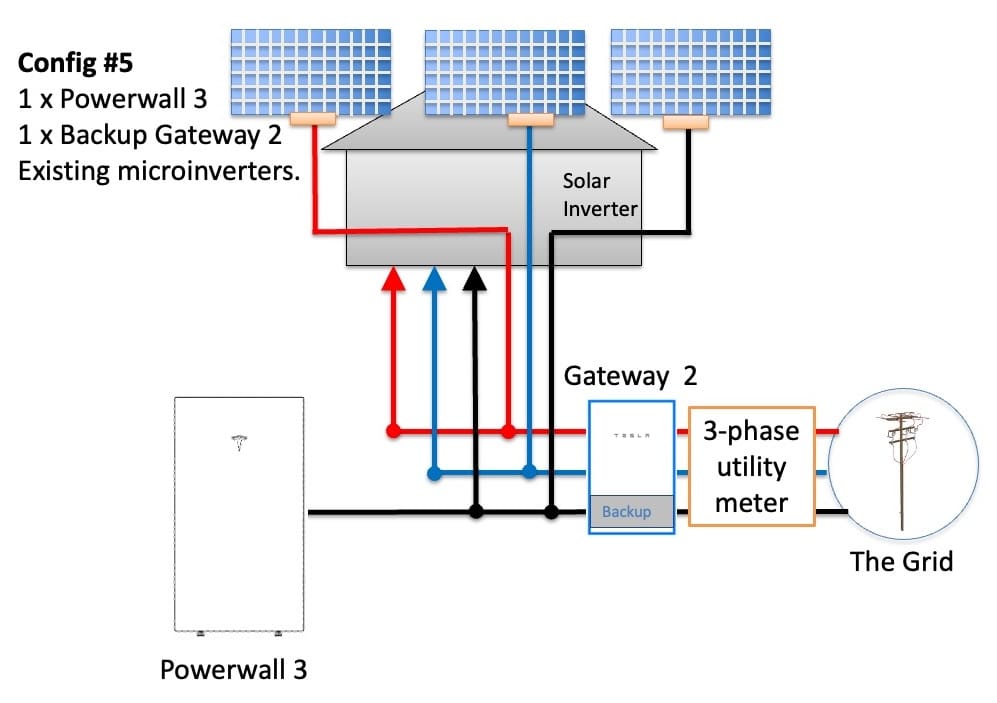
MIcroinverters
Config #6: Three Powerwalls on one phase of a 3-phase home.
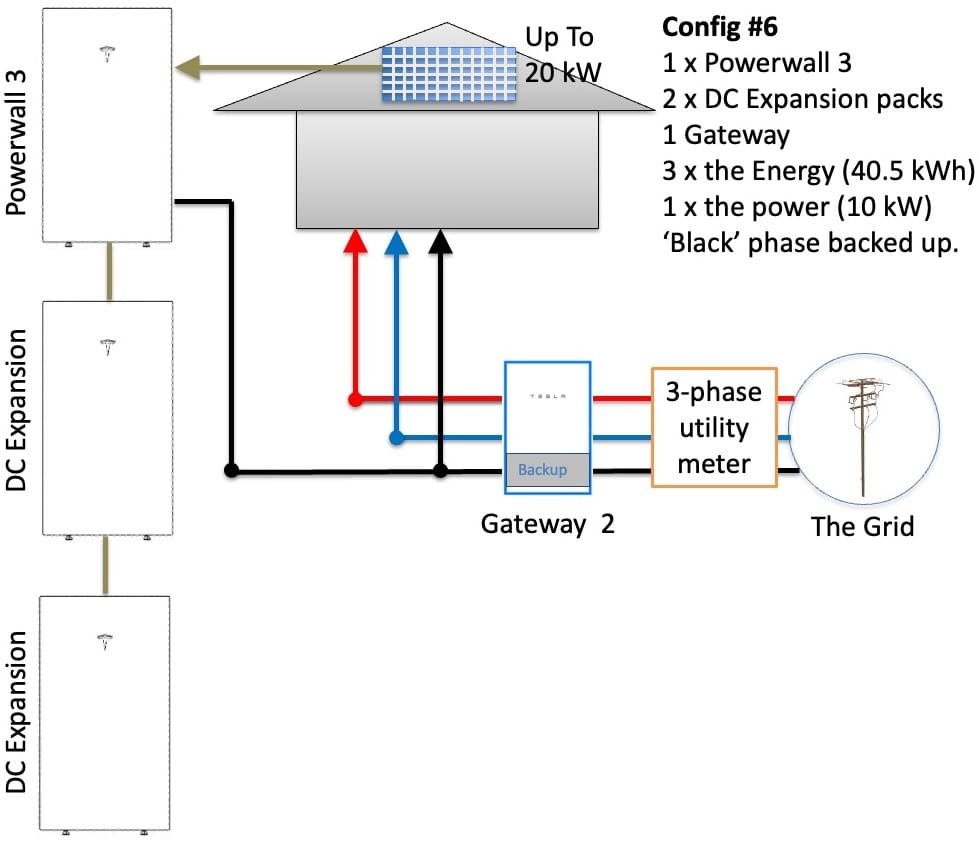
Three batteries an a single phase
Putting 3 Powerwall 3s on a single phase is not allowed by many DNSPs because it adds up to 30 kW of inverters on a single phase. The solution – if you want this setup – is to wait for the DC expansion packs which are battery-only and no inverter.
We’re told expansion packs are set to be keenly priced, and they’ll allow you to soak up solar faster.
Config #7: Three Powerwalls. One on each phase of a 3-phase home. One Gateway.
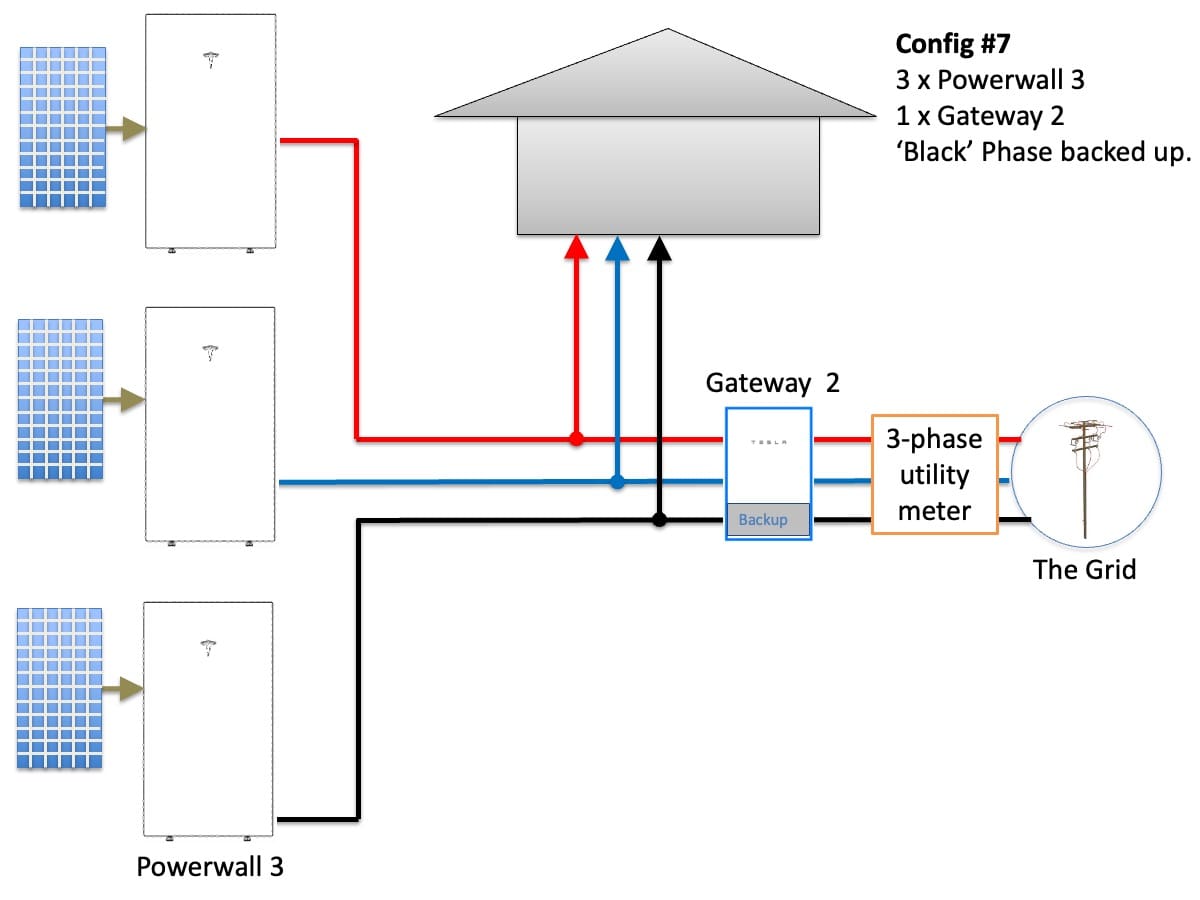
One battery per phase, one gateway
When the grid is connected, this will work exactly as you expect, with 3 x the energy (40.5 kWh) and 3 x the power (30 kW). In an outage you will only be able to use one Powerwall, which will back up the solar and loads on that phase only.
Config #8: Three Powerwall 3s on a 3-phase home with 3 Gateways.
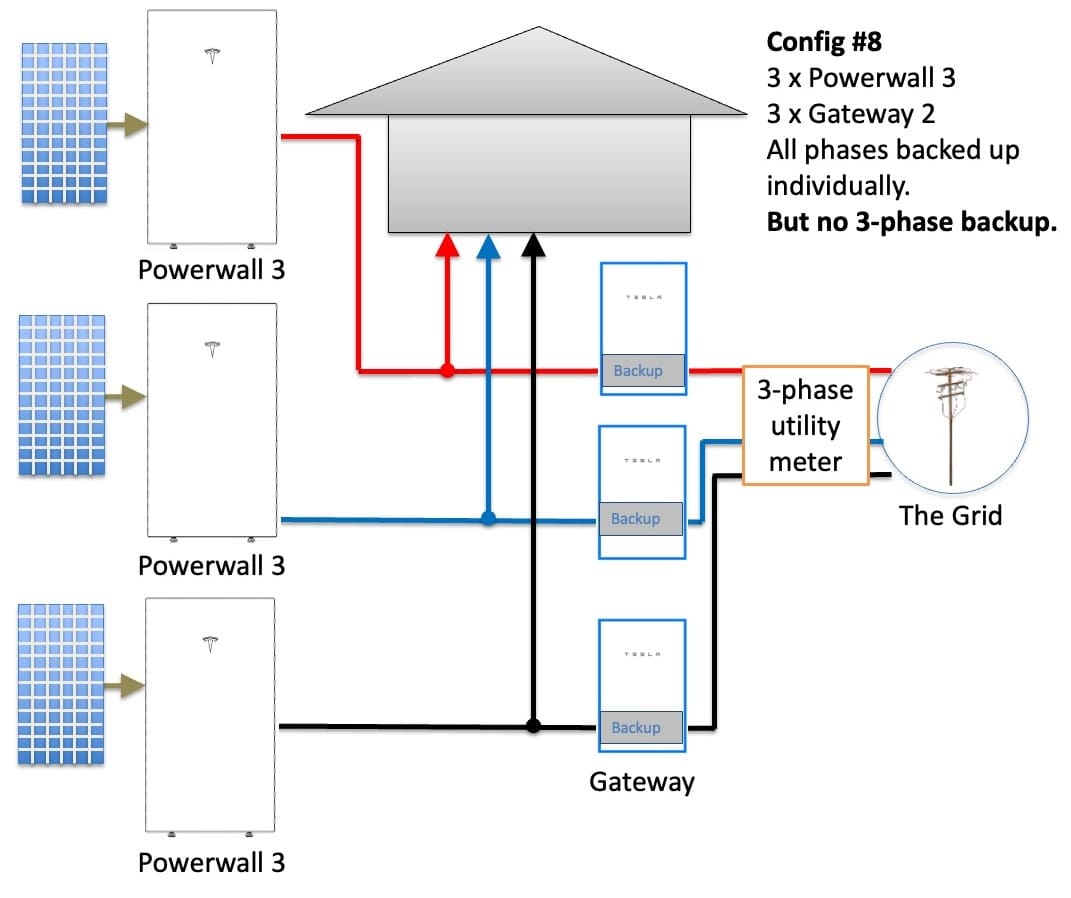
Three PW3s, 3 gateways, no 3-phase backup, lots of money and wall space.
Each phase is backed up individually, but it is not a 3-phase backup, as the phases are not synced. If a 3-phase appliance is attached, it won’t work in a warranty and should be on the non-backed-up circuit of each phase3.
This is a very expensive way to not back up a 3-phase home. Don’t do it—just buy a proper 3-phase battery system from Fronius, Sungrow, SigEnergy, etc.
Some notes about Western Australia and Powerwall 3 Throttling
If you’re lucky enough4 to live in the West, where 5kW per phase is the maximum allowed, PW3 is available as a 5kW nominal machine. Once it’s been commissioned though, there’s no unlocking it to unleash the full 11kW of power, unless you contact Tesla with bulletproof documentation from the DNSP that it’s allowed.
Seeing as the PW3 doesn’t charge at more than 5kW, the derating isn’t as bad as it might sound but sadly the backup capacity during an outage is also throttled to 5kW. I’ve spoken to Tesla and they’re trying to convince the regulators that’s a silly idea.
These 5kW Sandgroper Spec™ units will prove popular elsewhere as a workaround solution for those who simply must have a Tesla, but whose local network (DNSP) mandates a maximum 5kW balance between phases.
For example, if you have an existing 10kW 3 phase inverter, there’s effectively 3.3kW on each phase. An additional 10kW isn’t likely to be approved but 5kW will sail through automatically.
Perhaps you have a Fronius Primo 5kW inverter on phase A, a full sized 10kW PW3 could go on phase B, however you’ll need an additional 5kW of single phase generation on phase C to balance things up. I always recommend more solar so don’t be discouraged.
However if you don’t have more roof space, it makes sense to get a 5kW PW3 to balance your legacy Fronius, leaving the other phase alone.
Local Rules May Force You To Ditch Your Old Inverter
Flexible exports or dynamic connections are standard across SA, optional in Qld, coming soon to NSW, and becoming law in Victoria in less than a month. Once more, your DNSP rules need to be consulted carefully, but in many places, this means the faithful old SMA SunnyBoy TL5000 you bought 12 years ago will be forcefully retired.
The need to have network control for solar means old inverters that can’t be bridled with an internet connection can’t be used when you apply for a new PW3 to be connected. Sadly that means a deal of e-waste will be created but one silver lining is that Tesla’s very good monitoring app will let you know when the DNSP throttle has been applied, a feature only CatchPower has offered up until now.
Footnotes
Original Source: https://www.solarquotes.com.au/blog/three-phase-powerwall-3/

